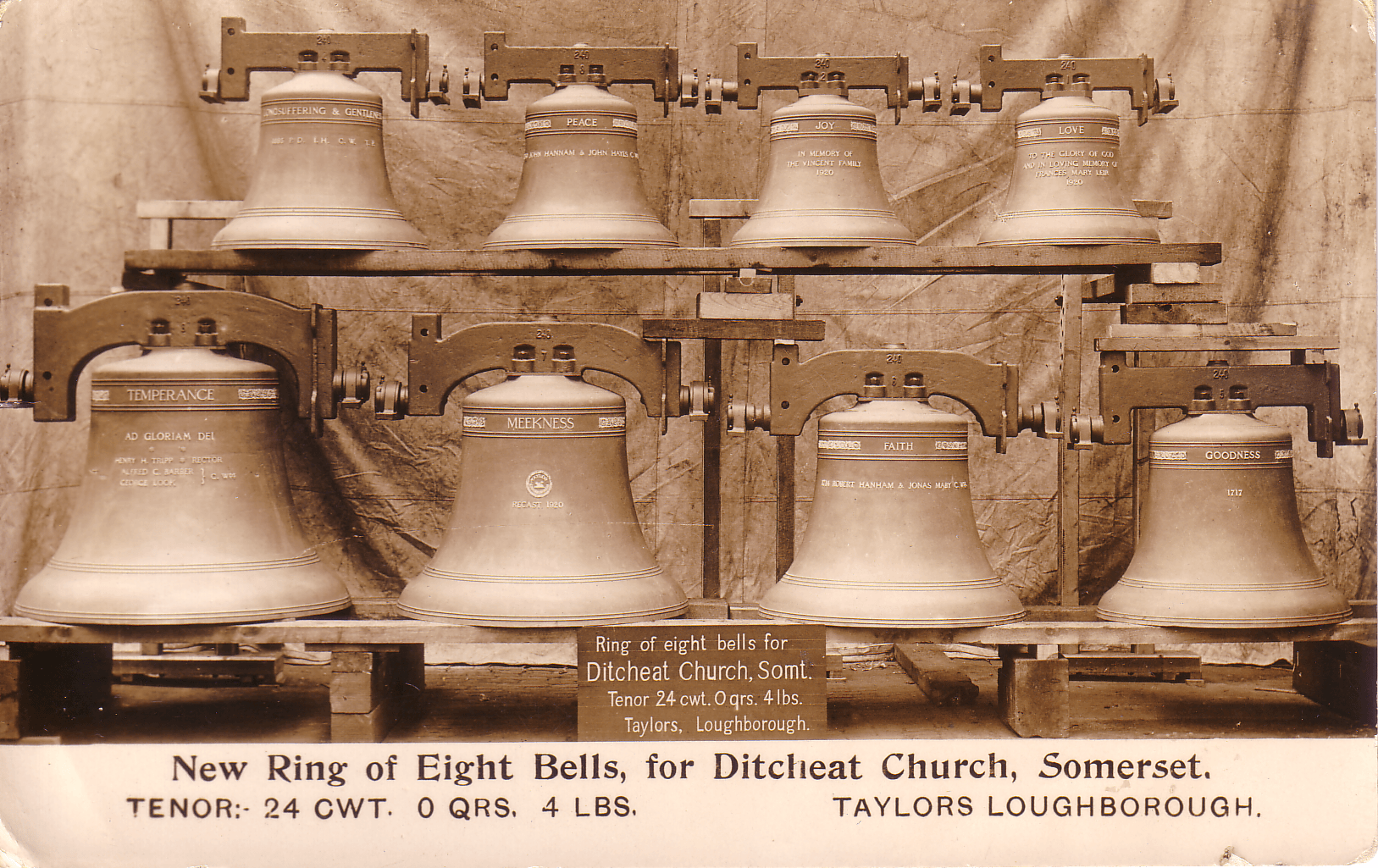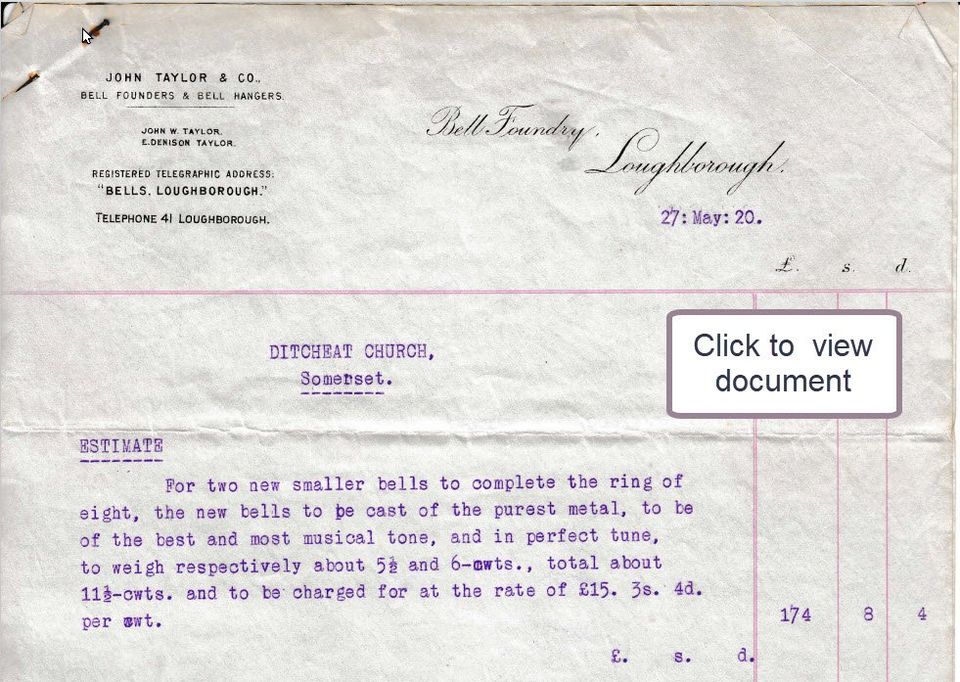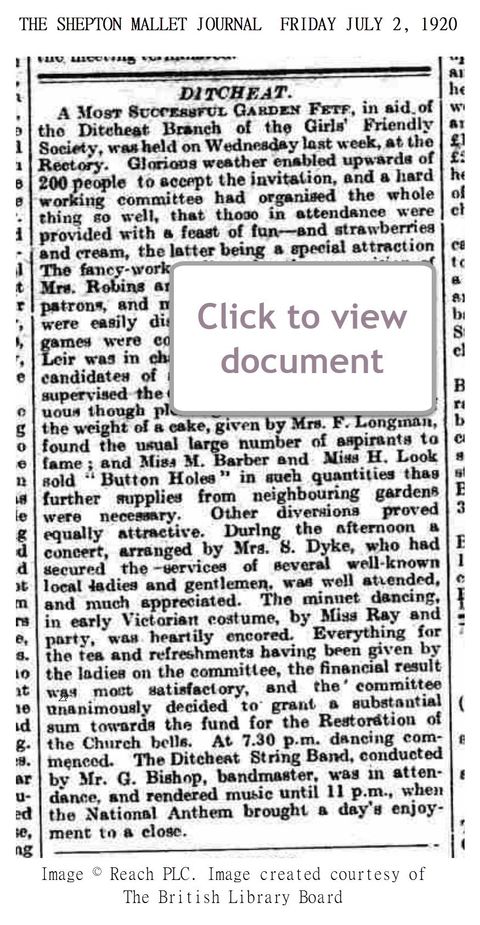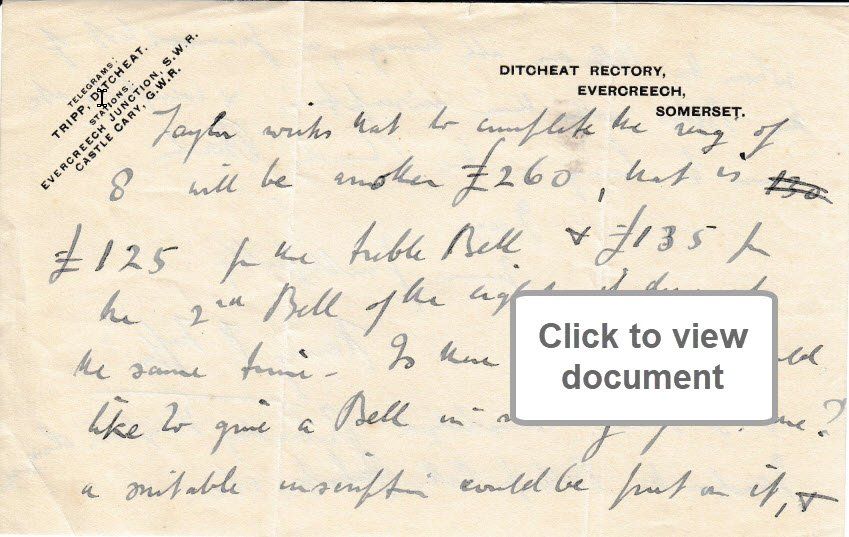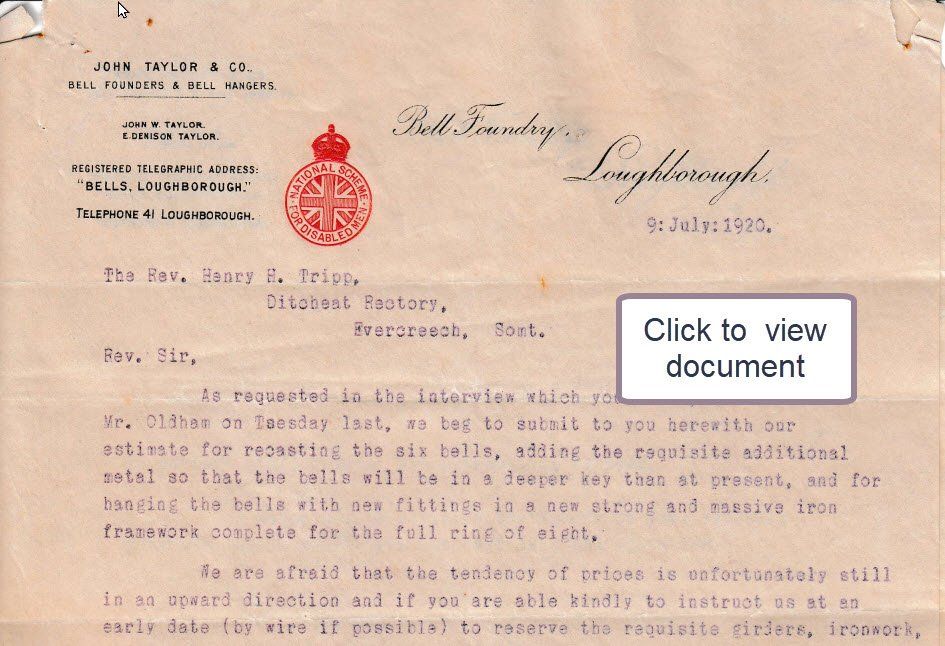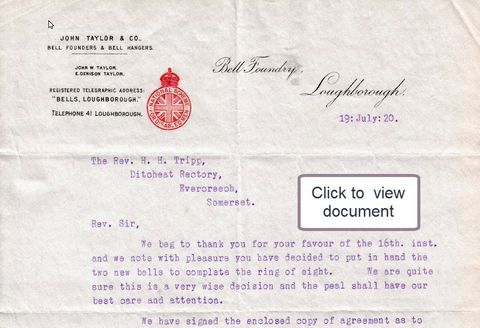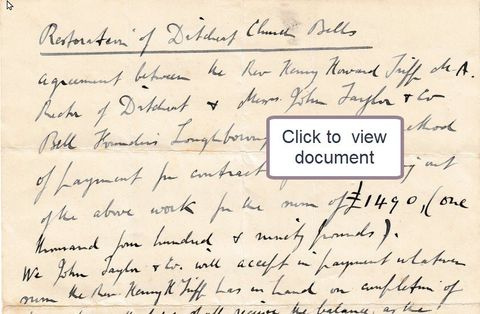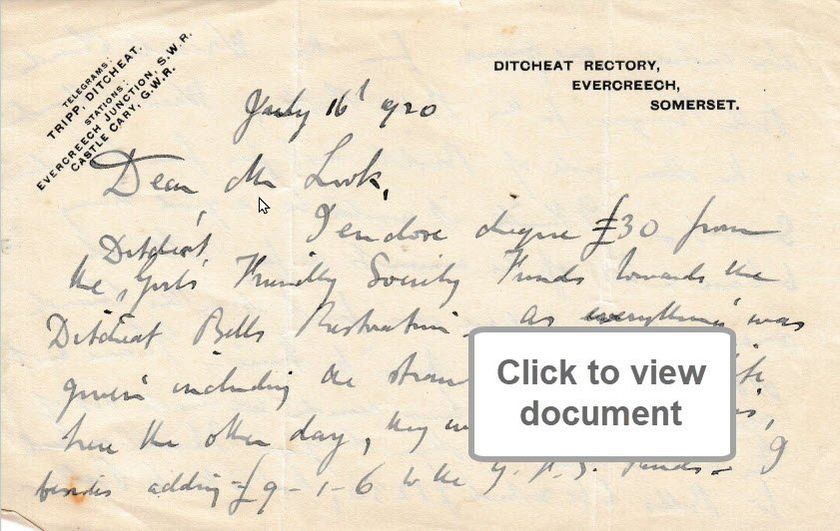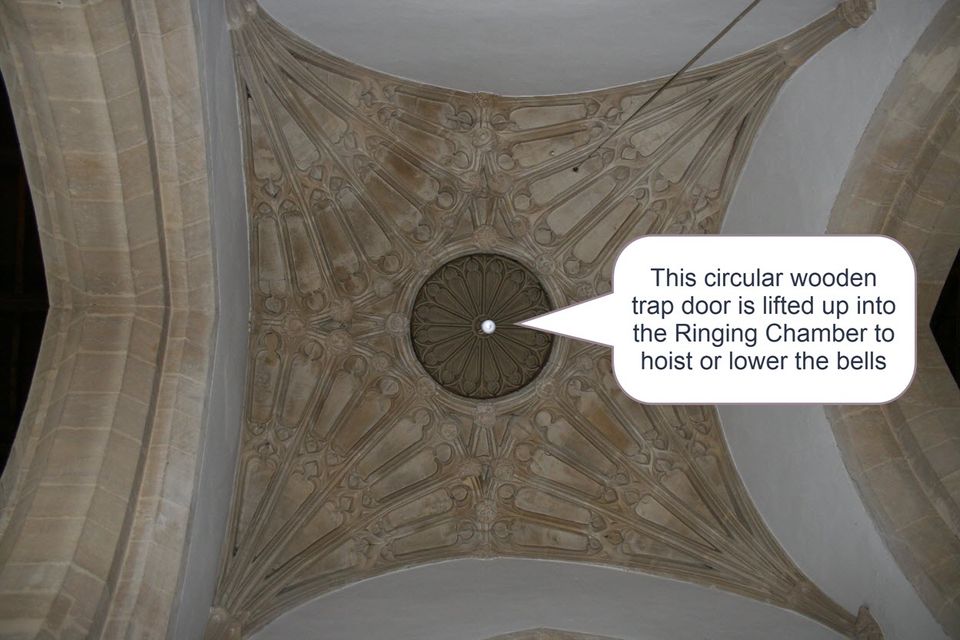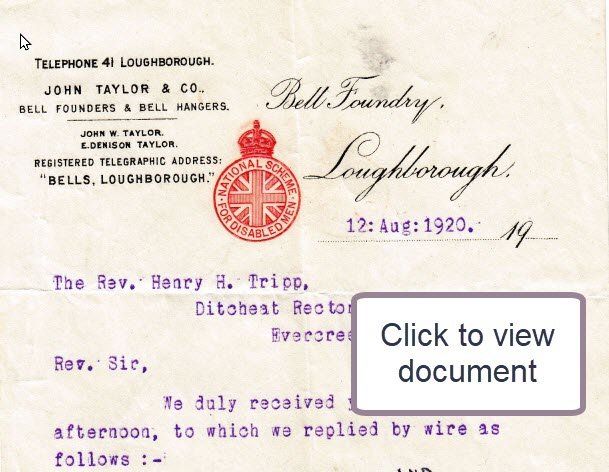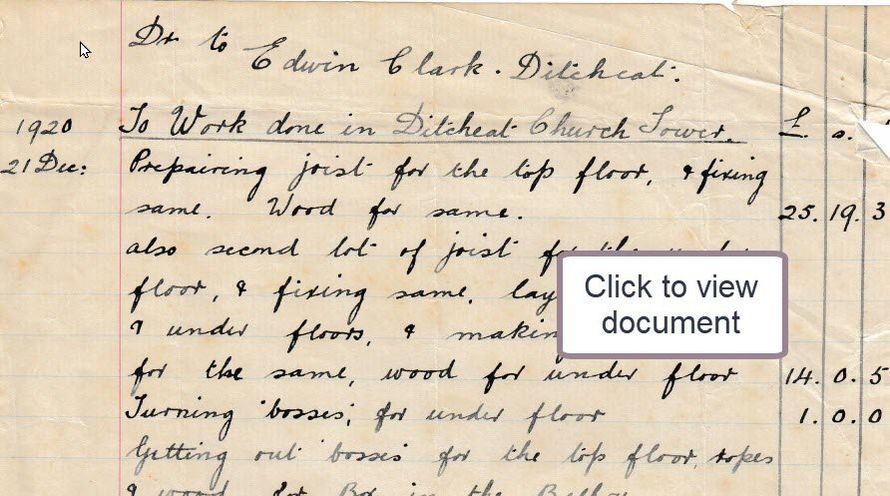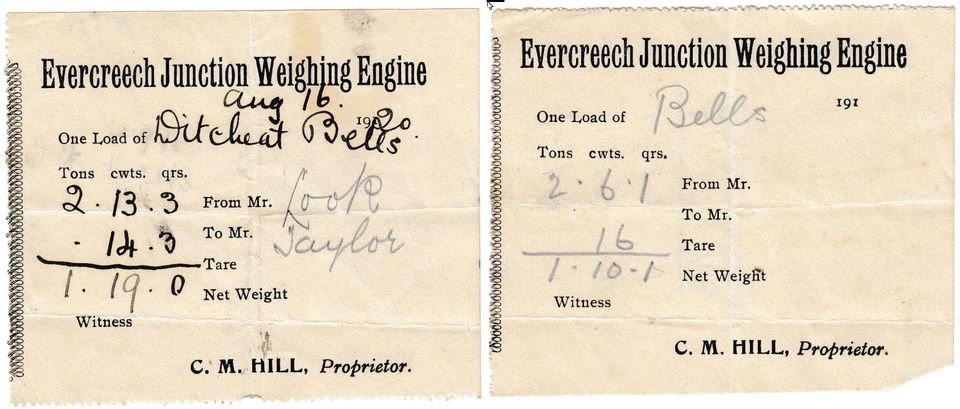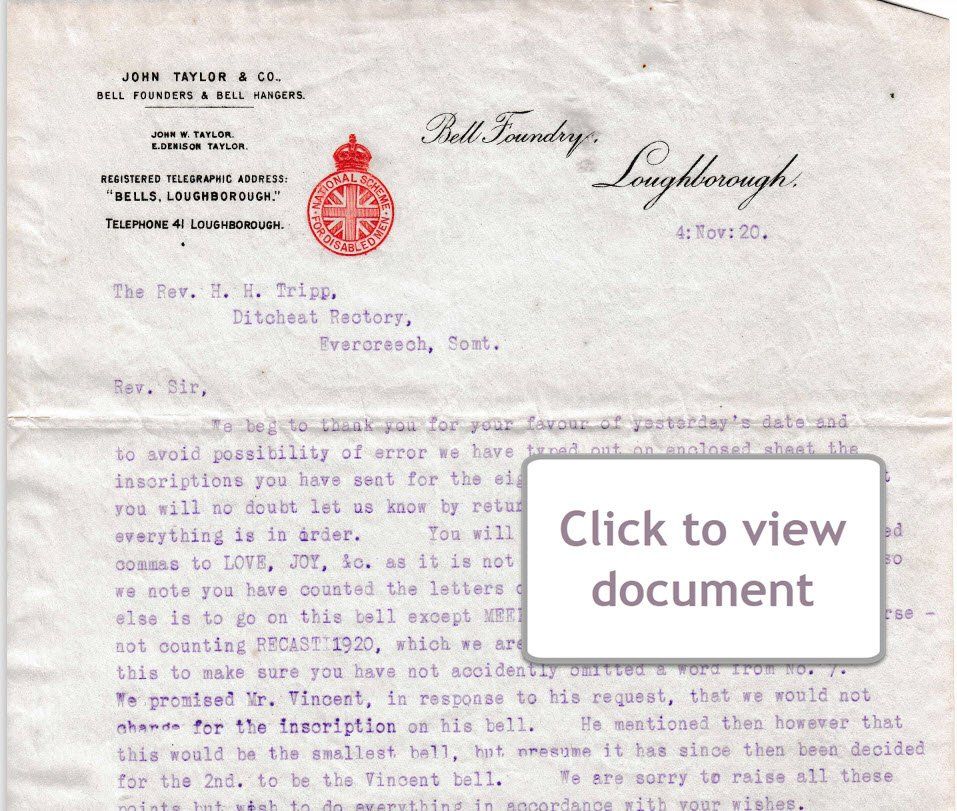Ditcheat Church Bells are 100 years old
The new bells were cast at at 2.00pm on Tuesday December 14th 1920
Information re-produced on this web page is taken from Tower documents and Shepton Mallet Journal Archives accessible at British Newspaper Archive (www.britishnewspaperarchive.co.uk)
The illustration below charts the introduction of bells to our Church, there was some form of church in Ditcheat from 824 , it was some 600 years before the first bell was hung in the tower and it took a further 400 years to evolve to one of the finest rings of eight bells in the land that we ring today.
In 1918 Ditcheat Church had 6 bells dating from 1750 although they had been recast in a renovation in 1902, there is a brass commemorative plaque in the church next to the tower stair door. This LINK reproduces the "The Bell Re-opening" reported in the Shepton Mallet Journal, it will be of particular interest to bell ringers who appreciate the present quality of Ditcheat Bells, it has not always been so.
This page tells the story that unfolded to augment the ring to eight bells in 1921. A project that was driven largely by Thomas G Vincent, Tower Captain and Reverend Henry H Tripp.
The name TG Vincent is synonymous with Bell Ringing in Ditcheat, because there were two, father and son, successive in the role of Tower Captain. Trawling the newspaper reports of the Ditcheat Ringers Annual Supper, It appears that TG Vincent sn. began ringing in 1850 becoming Tower Captain in 1888 and was still grandee at the Annual Supper in 1920.
TG Vincent sn. at the 1906 Supper, in responding to the Toast to the Bell Ringers said “I hope to be spared a few more years to see things go on as satisfactorily as they have been in the past, and that when it is time give up the work, my successor will strive to maintain the same efficiency.” He was referring to Tom Vincent jn. upon whom his father’s mantle was expected to fall.
Due to the War the Suppers were suspended in 1915 and resumed in 1919, it is thought Tom Vincent jn. became Tower Captain some time in this period.
This LINK to a typical Bell Ringer Supper report.
We know that all was not well in 1918 as the 3rd bell was cracked, The Rev Henry H Tripp and Tower Captain Tom Vincent from Lower Wraxall Farm were costing a renovation to recast the 3rd and add two new bells to make a ring of eight, hung in a new iron frame. The estimate dated 2nd December 1918 was for £772 19s 4d.
However, a year later the 4th bell was also cracked, the scheme was reviewed to recast all 6 bells including adding two additional bells “so that the peal shall be deeper in pitch, of the best and most musical quality of tone and in perfect tune true harmonics”. The new estimate dated 27th May 1920 was in the sum of £1,462 2s 6d
There must have been some caution in the proposal to spend £1,462 2s 6d, money they did not have. Another option was explored where the existing 6 bells would be recast but hung in a frame made ready to hang eight bells. This document was poor quality and had a handwritten copy attached.
A hand written notes from Rev Tripp keep George Look updated, explains the cost of the two additional bells with the view for private donation.
John Taylor & Co, Bell Founders & Bell Hangers sent their representative Mr Oldam to Ditcheat on 6th July to confirm the specification, and offer payment terms, “that you should pay us whatever sum you have in hand on completion of the work, and to pay us the balance as the money comes in, no interest to be charged by us for 12 months after date of completion. Interest to be charged on any balance then outstanding at the current bank rate.” The letter concludes “We trust to be favoured with your esteemed commands and you may rely upon the bells being the most musical and perfect possible, and in the best ringing order. The new fittings would include all those improvements we have made in recent years in this direction, including ball bearings for the gudgeons to swing in, which will reduce the friction to a minimum and require lubricating only at intervals of several years instead of every week or two as do ordinary bearings. The framework too would be very strong and massive, and the bells would be in perfect ringing order for generations to come”
The order was confirmed and the payment agreement signed on 19th July 1920.
The second note to George Look reports on some donations received including one from the Wraxall Bell Ringers (we now know as Wraxall North Somerset). He also confirms he has placed order for 6 bells.
The project began very quickly, the six bells and the wooden frame had to be removed from the tower, there is a wooden trap door in the Fan Vault over the crossing that can be lifted up into the Ringing Chamber. After the 1902 renovation there was no expectation that the bells would have to be lowered so soon, there was no provision made, the ringing chamber ceiling had been completely re-boarded.
We learn from this letter that Taylors bellhanger, Bentley, was in Ditcheat to remove the bells during August and that cutting the access between the ringing chamber and the bell chamber was not within the scope of their works.
This invoice dated 21-Dec-1920 from Edwin Clark, a village carpenter, shows that he cut the trap doors
It is apparent that the project was run by The Rev Tripp, there is no Parochial Church Council involved, progressing through the records only two other people are mentioned, George Look (Church Warden) and Tom Vincent (Tower Captain).
I particularly like the language used in the letters and note that Ditcheat's postal address was Evercreech, not Shepton Mallet.
It didn't take long to remove and lower the bells to the floor in the centre of the church, they then would have been pushed on a trolley or rollers outside and then hoisted onto a cart using shear legs.
Mr Look then hauled them to Evercreech Junction Station, the weighbridge tickets are dated 16th August just four days after the problem with forming the trap door
We learn from Taylor's letter to Rev Tripp dated 4th November 1920 that there has been communication now between Taylors and Tom Vincent, discussing the detail of the installation and the position of the rope holes in the floor. Tom Vincent was determined to have the best layout possible and improve on what existed before. We can confirm that it was achieved, we have a fall of ropes in as true a circle as any tower.
At some point in the project it was decided to overhaul and reposition the clock and install new striking hammers.
We also learn from this letter that the inclusion of Ellacombe striking apparatus has been dropped.
The invitation was made to attend the Loughborough foundry to witness the casting in about one month.
By this time the cost of the two additional bells were to be covered by private donations from the Leir and Vincent families. The 2nd was to be attributed to the Vincent family and Taylors were making a gesture to Tom Vincent for not charging for the inscription on the 2nd bell.
Read a special moment with the "Joy bell " at this LINK
The new bells were cast at 2.00pm on Tuesday December 14th 1920, Taylors invite representatives to Loughborough to witness a casting, Rev Tripp attended probably accompanied by Tom Vincent. He said “it was a magnificent sight to behold the seven tons of molten white hot metal poured from a huge ladle into the bell moulds in turn.”
This You Tube video taken nearly 100 years later records the The Lawrence Bell for All Saints Church, Hawton being cast at John Taylor's Bell Foundry on 14th December, 2017 LINK
Part 2 to this story will be published early in 2021 to celebrate the return of the bells to Ditcheat and the rehanging in February 1921.
